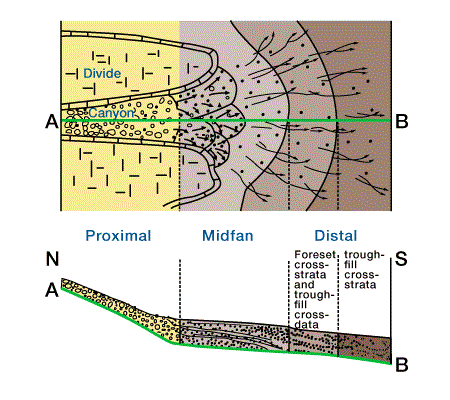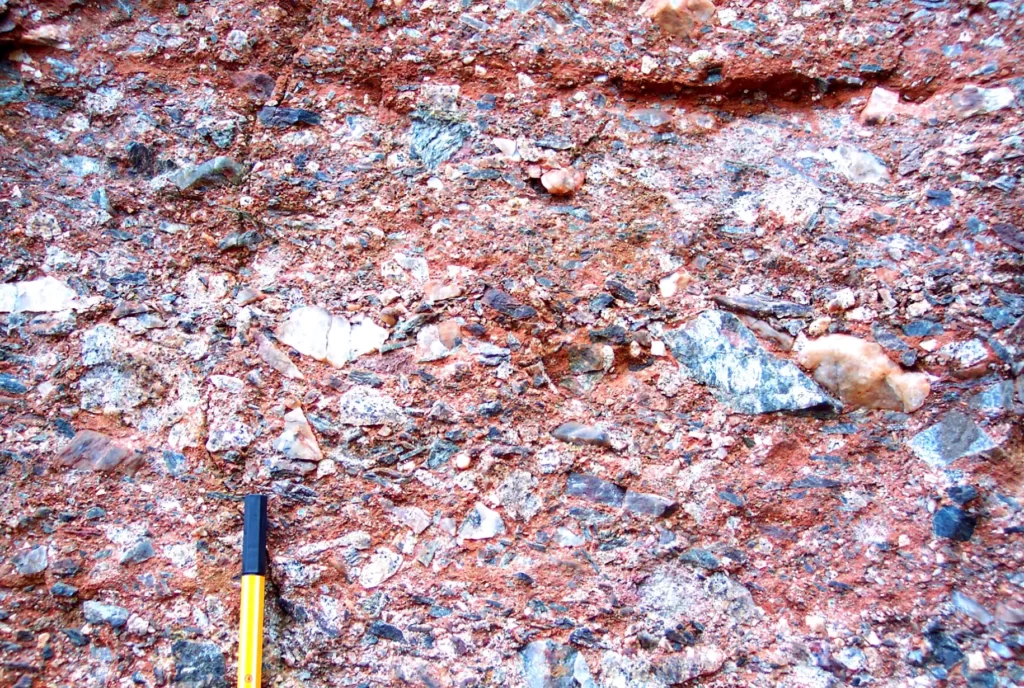Depositional Processes and Lithologic Characteristics
Sedimentation on an alluvial fan takes place mainly by a combination of:
- braided stream channel flow
- debris and mud flow (gravity sliding)
- sheet flooding
Most modern and ancient fans, if adequately mapped, can be divided into proximal and distal subfacies. For the first of these, proximity to the sediment source, very steep drainage slopes, and often irregular, but high discharge makes for deposition of detritus that is typically an unsorted mixture of boulders, gravel, sand, clay, and possibly organic (soil) material. (Figure 1, Plan view of cross section of a single canyon and the alluvial fan which developed at its mouth, Van Horn Sandstone, Precambrian (?) Texas.

Shown are the downfan decrease in slope and grain size, as well as the higher concentration of sedimentary structures in the distal portions. The overall progression grades from massive conglomerate/gravel of the proximal fan, through alternating trough and foreset crossbedded sand of the midfan, to finer-grained, more thinly bedded crossbedded sands of the distal fan.) This type of sedimentation occurs right up against the mountain front itself. In addition to high energy stream deposition, landsliding, in the form of debris and mudflow, is also common. Down-fan, where braided channel flow begins, more gravelly beds alternate with crossbedded sands. With greater distance from the mountain front, the proportion of sand increases, and the shallow cut and fill of braided channel deposits predominates. Mudflows may occasionally spread finer-grained clay material over parts of the fan.
Preserved alluvial fan complexes, therefore, usually show the overall lateral and vertical progression shown in Figure 1. Vertical sections are usually dominated by a large number of stacked sequences that each show an upward change from conglomerate to coarse and medium-grained sand. Each sequence is truncated abruptly by the next overlying sequence, indicating the lateral shifting of the braided channels over the fan. Most identification of fan facies in the rock record, however, has concentrated on the distinctive fanglomeratic lithologies. (Figure 2, Photograph of fanglomerate, Colorado. This particular section was part of a fan system that spread from the basement block uplifts of the Ancestral Rocky Mountains in Pennsylvanian time.)

A number of specific sedimentary structures will be found in fan sediments. These will be concentrated in channels, where current action is most dominant. Cross-bedding, pebble imbrication and long axis orientation, current lineations (from smaller grain orientation, for example), dune and ripple morphology are those most commonly found. In addition, the long dimension of channels can be used to derive paleocurrent patterns. These will show the overall morphology of the fan, since most stream flow is directly down the steep slopes, i.e., “fanned” out. Detailed paleocurrent information is not often systematically collected for fan deposits. The downfan (basinward) direction is usually fully evident from large-scale stratigraphic parameters, or from seismic and structural data.
Paleontology
As might be surmised, macrofossils are relatively rare in alluvial fan complexes. Some vertebrate bones and plant fragments may exist, the result of sudden burial due to flooding. Normally, however, the depositional caprice of the fan environment prevents any significant floral or faunal colonization. Microfossils, such as spores and pollen, have a far better chance of being incorporated. At the same time, percolating groundwater within the fan would be acidic and these often-valuable remains have a strong chance of being strongly oxidized, thus partially dissolved and often altered beyond recognition.
 Petro Shine The Place for Oil and Gas Professionals.
Petro Shine The Place for Oil and Gas Professionals.



